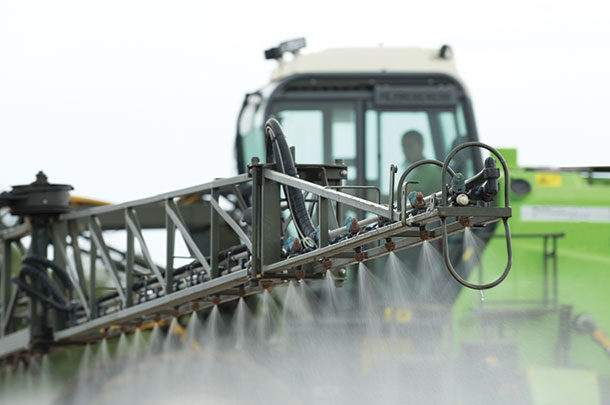For many forage growers, this rise in dicamba drift incidents is particularly interesting due to dicamba applications being widely used on certain forage crops with few drift issues in the past. Drift can happen with all pesticide applications. But taking certain precautions can limit your liability.
Applicators should remember to follow the label; many cases involving liability for damages from drift turn on whether the applicator followed instructions on the label.
In the majority of cases, proving that an applicator is liable for damages is difficult unless the injured party can demonstrate the applicator did not follow all the safety precautions, witnesses saw the drift cloud during application or application was made during less-than-ideal weather conditions. Keeping all these factors in mind will help to reduce your liability when applying pesticides.
In Mangrum v. Pigue, an Arkansas case, a neighboring farmer claimed that negligent application of Roundup Ultra killed his corn. The Arkansas Supreme Court found no evidence showing the commercial applicator was negligent in the application. The applicator (who was the only witness) stated the applicator followed the rules in the application, no witnesses saw a plume of chemical drift hit the neighbor’s corn, applicator used a common chemical and the application took place with minimal winds. Mangrum is an excellent example of a court finding no liability with an application.
On the opposite end of the spectrum is a Texas case, Boyd v. Thompson-Hayward Chemical Co. In Boyd, an aerial operator was hired to spray 2,4-D on a field, and the spray drifted, injuring a neighboring landowner’s cotton crop. The injured party demonstrated the aerial operator knew that 2,4-D could injure cotton and that there was cotton in the area. Witnesses saw the operator continuing to spray as he flew over property lines to turn around. Finally, the operator knew that it was windy because the wind had forced him to quit spraying each of the three days before the incident.
One decision to highlight for forage growers is out of Oklahoma. In Young v. Darter, the Oklahoma Supreme Court held that a landowner using a weed killer (in this case 2,4-D) did so at his or her peril and would be liable for the damage, regardless of demonstrating negligence by the applicator, and the 2,4-D drift injured the neighbor’s cotton crop. Cotton is one crop that is susceptible to damage from 2,4-D, which is one reason the court applied strict liability. It is important to note, this decision has not been cited in another decision since it was decided, but is still good case law.
Pesticides must be used for purposes consistent with the label. In the Louisiana case Johnson v. Odom, Johnson was a commercial applicator who lost his license following run-ins with the Louisiana Agriculture Department. Johnson continued to operate as a commercial operator after his license was revoked.
A state agriculture official took photos from a public road of Johnson applying chemicals. Johnson sprayed the state official during the application. The state agriculture department found this use was inconsistent with the approved label and imposed the maximum fine against Johnson.
The state court agreed with this determination and affirmed the state’s decision. In reviewing many of the cases, this is where an applicator can get in trouble – when the application is inconsistent with the approved label.
But what should you do if you suspect drift damage in your fields? An injured producer should contact the state department of agriculture to investigate, begin developing evidence of the damage, consider working with the applicator and/or neighbor to settle the damage, or hire an attorney to pursue a lawsuit in court. Understanding how to handle drift damage can help the injured producer understand his or her rights in this situation.
The state department of agriculture governs pesticide applications in most states. You should immediately report the drift damage to the state department of agriculture to begin investigating the potential violation. The state will investigate the potential drift incident; interview the applicator, witnesses and other parties; collect samples; review records; and collect other evidence.
If the state finds a violation has occurred, then the state can impose fines against the applicator. These fines will not, however, be the same damages paid to an injured producer for crop damage but will go directly to the state. It is important to note this process can take time and can be frustrating to the injured producer.
What else can you do besides contacting the appropriate state agency? Begin to document the damage. Take photos that demonstrate the damage, and take samples of damaged crops and other plant life. If you know the date the application took place, document the weather conditions on that date including temperature, wind speed and wind direction.
Ask neighboring landowners if they witnessed any recent applications in the area. The more documentation you have will help you down the road.
Once you have an idea who caused the drift, you may want to try dealing with the issue outside of court, which may help preserve relationships with neighbors. One way to do this is stopping by to talk with the neighbor about the drift damage.
You can also consider contacting an attorney to file a civil lawsuit in court. Any damages awarded in court would go to compensate you for the drift damage. Documentation developed early on would be useful when going to court. If you make this choice, you should discuss options with an attorney, as the state’s investigation of a violation going to court can be a lengthy process.
When faced with potential drift damage, contact the respective state department of agriculture to report the damage, begin developing documentation to show the damage, consider working outside of court with the applicator and consider contacting an attorney to file a civil lawsuit. ![]()
PHOTO: Understanding how to handle drift damage can help the injured producer understand his or her rights in this situation. Photo by Getty Images.
This article is not legal advice.

-
Paul Goeringer
- Extension Legal Specialist
- University of Maryland
- Email Paul Goeringer










